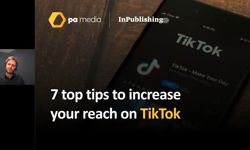
This Publishing Workflows Special consists of nine separate sections:
Content commissioning & creation
Content publishing & distribution
TRENDS
Multiple usage of content

According to Ross Paterson, CEO, WoodWing, “Publishers have realised content is far too valuable to only be used once. By planning the reuse of content in advance, it can efficiently be repurposed and redeployed across various platforms, titles, countries and business units.”
Catherine Westwood, group editor-in-chief, Future, concurs: “We are trying to be more linear in approach so that content is created to perform on many levels – but predominantly print and digital usage.”
To take optimal advantage of every piece of content you put out, an efficient, proactive approach to rights management is essential, says Phil Arnold, managing director, censhare (UK): “Content commissioning needs to be driven by accurate rights management, ideally linked to contracts that the publishers have in place with the content creators and providers. This allows for rights information to be captured, as automatically as possible, even before the content is submitted rather than being potentially neglected during the later stages of the production process.”
One eye on the commercial
The old church-state divide between editorial and commercial is blurring. Editors are increasingly being expected to take commercial potential into account when commissioning content.
Future’s Catherine Westwood: “We ask if the content has a commercial opportunity. For instance, can shoot pictures be resold? Is there an awards opportunity so we can monetise via cost to enter and subsequent licensing of award logos? Are there sponsorship opportunities? Are there e-commerce / affiliate deals to be done?”
And it’s not only the commercial potential of editorial content that needs to be taken into account as journalists are increasingly being expected to write branded content pieces sold by commercial teams.
For Rob van Dorp, director, AdFactory International, the “growth of branded content (called ‘advertorial’ in the old days)” and the creation of promotional packages that include an “editorial” element are key trends.
Fewer people doing more
The pandemic has led to big cuts in editorial staffing at many publishers and the staff that are left are having to do a lot more and to also reacquaint themselves with aspects of the job that they perhaps hadn’t done for some time.
Christopher Ludwig, editor-in-chief, Ultima Media: “Cuts in overhead have hit editorial and production departments in many cases, with fewer editors, journalists, designers and sub-editors. That has meant more overlap in teams and roles, as well as planning and execution. Editors are planning, sourcing contacts, writing, editing, uploading, etc, as well as supporting more input and tasks across marketing, social media and digital channels.”
Increased use of external resources
“Publishers are increasingly using external writers, photographers and content repositories, a trend that has been apparent for several years now, witnessed by a general decrease in internal FTEs, and largely driven by the need to cut costs,” says Paul Driscoll, publishing director, Media Systems Limited: “It’s clear that external resources, both in terms of people and content, form a significant part of the current publishing process. It’s a trend that is likely to continue, probably until the tipping-point is reached when the optimum balance between internal and external is reached.”
WoodWing’s Ross Paterson has “also seen an increase in the use of external contributors in production processes. The pandemic has forced some dramatic cost-saving initiatives by publishers, which has resulted in a reduction in internal employees. More use of external contributors – such as photographers, copywriters, or designers – gives publishers extra agility, but only when workflows and processes are optimised to keep everyone on track with deadlines and allocated tasks.”
Data-driven commissioning
An editor’s hunch that a piece will be a good fit is no longer enough.
Geoff Marsh, online director, Daily Express: “We increasingly expect content suppliers to understand the world as it is, just as we have to. Previously, we would have only asked: “Is this a good story?” Now we increasingly add: “Is there a market for this? Why do we believe that? What’s our competitive edge? What are the effective means of distribution for this?” It’s a much more comprehensive way of assessing whether content is “good” or not. The best story in the world is only of any use if people read it – now we think a lot more about that before we publish.”
Similarly, in the B2B world where an understanding of the utility of the content to the target market should be the determining factor, “using analytics about what readers are engaging with to help with commissioning,” says Edwin Bailey, director of marketing & research, Publish Interactive: “Understanding what content is popular, shared and has good dwell time should be at the heart of editorial departments.”
“Knowing what your reader / subscriber is doing with the content and how it feeds in with their work tasks is imperative. Analytics can only tell you so much, it’s important to speak with users to get insight into their working lives.”
“Through this understanding, commissioning can be guided to ensure content aligns with user interests and needs which should increase engagement and renewal rates.”
Collaboration and remote working
“Especially since the world started to work from home, easy editorial collaboration has never been more important,” says Andy Kowl, senior vice president – publishing strategy, ePublishing: “Having one central system where everyone can work together and always have the latest version is essential.”
According to Sean Briggs, managing director, Creative Workflows, “the mistrust of online storage solutions has mostly evaporated as teams are forced to share content across the internet. Finding elegant ways to collaborate through cloud services is high on many publishers’ agenda.
Carsten Althaber, director of marketing, vjoon, sees the trend for remote working continuing after the pandemic because the nature of work has changed for good: “many companies will continue to optimise their content creation processes and invest more in software for collaborative planning and coordination.”
Ross Paterson observes that “businesses that invested in a cloud or SaaS-based content creation ecosystem before the start of the pandemic transitioned almost seamlessly to the new reality of working from home and can better coordinate external contributors.”
COMMON AREAS OF INEFFICIENCY
Not enough time
One of the biggest headaches for editorial management is how to achieve what they want to achieve with limited resources.

According to Adrian Barrick, group editorial director at Incisive Media, “one of the biggest challenges facing editors is the demand on their time from virtually every part of the business. As the face and voice of the brand, editors have always been central to the success of so many ventures – from events to commercial partnerships. But as digital and live media has grown, those demands on time have expanded exponentially in some cases. Figuring out how best to use an editor’s time and talent is one of the key challenges facing publishers.”
Catherine Westwood is concerned about the impact these time pressures have on editorial quality: “Time pressures also lead to underperformance. If teams are not meticulously organised, it’s easy to become quickly overwhelmed with workload, especially if copy is sent back with amends. However, if content creation staff apply the ‘creating once’ principle, this should eradicate any need for duplication across print and digital and therefore lead to better time management.”
But it’s not just lack of staff that publishers need to be concerned with, it’s also making sure staff have the right skills and are properly trained. Westwood again: “Content creation teams are not thinking smarter – about how to create content once, and serve it up in different ways to best suit the platform. Lack of knowledge can lead to underperformance. In some business areas, legal knowledge is essential. Writing copy without an understanding of media law means the copy has to be re-written, sometimes multiple times, to get it approved for publication by our lawyers.”
Poor planning
For Ultima Media’s Christopher Ludwig, forward planning is proving increasingly challenging: “With a new, evolving and changing product mix, forward planning is also a challenge and can cause inefficiency. It is harder than ever before to plan a stable editorial calendar 6-8 weeks in advance let alone 10-12 months. Editorial teams need to be flexible and yet still require forward planning and alignment on products, especially where the content has rich opportunities to cross pollenate and expand reach.”
Editors themselves need to question their approach to commissioning content. According to the Daily Express’ Geoff Marsh, “Not understanding your market, or assuming there’s demand for a story – or a topic – just because you believe there is,” is a mindset editors need to be wary of.
Publish Interactive’s Edwin Bailey agrees that “commissioning work just because it interests creators or seems timely whilst ignoring hard data about engagement” can lead to under-achieving content selection.
Inefficient processes
“Communication continues to be a top cause of inefficiency and under-performance. The old questions of who is working on what and at what stage the work is at continues to eat time. Many editorial teams also spend way too much time trying to find the content they need to work on despite having asset management solutions in place,” says Creative Workflows’ Sean Briggs.
“Duplicating workload when attempting to produce multiple versions of a single story,” wastes considerable time, says Rich Mansell, solutions manager, PCS Publishing: “This is made worse when content created with one channel in mind is then being duplicated to fit within other channels. If an organisation’s desire is to produce multi-faceted content, then that should be the focus when producing the content originally, and not repurposing content intended for a single channel.”
According to Ross Paterson, “organisational silos often exist within publishers. Lack of transparency between teams means that there can be duplication of effort, missed opportunities for collaboration, and reduced ROI on content as it is rarely reused. A lot of money and time is wasted.”
Paterson also believes that time is wasted by not reusing more content: “Publishers also produce more new content than they need to, neglecting the wealth of content they’ve already created. Failure to reuse and repurpose content means it can be under-consumed or not consumed at all. Analysing the full content life cycle can result in several content pieces from a single assignment. In this case, less is more.”
When it comes to reusing content advises censhare’s Phil Arnold, “there is also a growing need to comply with data retention and reuse rules especially with changes introduced by GDPR. We are starting to see the problems related to permission being given by members of the public to appear in video and images and a mechanism for each person to remove that permission in the future. Without a robust procedural and technical solution in place, this can easily become a time consuming and error prone task.”
Inefficiency can also be caused by using disparate systems, observes AdFactory International’s Rob van Dorp: “The use of different systems for various output media is ineffective.”
Poorly designed submission processes
“Content is still often created in a format of the creator’s choosing with little to no standardisation,” says Phil Arnold: “Standardising on a single format for submitted content allows for far more efficient repurposing and whilst it will likely introduce some overhead at the start of the process, if the benefits can be articulated as part of the change management process, it can help enormously in gained efficiencies further down the line.”
“Standards for minimum metadata on image and video content can also be stipulated on initial ingestion to ensure accurate and timely rights information. There is growing interest in the advances in artificial intelligence engines for automated tagging of images.”
It’s important to have proper processes adds MSL’s Paul Driscoll: “Unless there’s a suitable process in place, there can be a lot of effort involved in ingesting the content and ensuring it lands in the correct area of the CMS. Further to that, without a system, content that needs to be transformed prior to ingestion adds yet more manual effort, something that is best done automatically as part of the workflow.”
Poor cost control
According to Paul Driscoll, “cost control is a main issue. Commissioning editors are often blind to the real-time costs, can’t see the running-total of the current commissions cost compared to budgets, have no enforceable approval processes and can only know some time after publication the true cost of the commissions and thus the true cost of an issue. And even then, to find that out often involves a lot of manual effort and is of course subject to error.”
Failure to invest in the right tech
Publishers have been slow, says ePublishing’s Andy Kowl, to adopt new technology: “Twenty years ago, we used to manage our editorial using Word docs, in desktop folders, sending them back and forth in email. It never ceases to amaze me that most editors I meet are doing the same thing today. Google docs are no better. It’s crazy. What other profession is using 20-year-old technology?”

Steve Chapman, senior vice president, content partnerships, PressReader, says: “not all publishers are investing in technology at the same pace. So, old CMS systems, old platforms for distributing content digitally,” are still commonplace.
For vjoon’s Carsten Althaber, “one of the biggest problems is the available bandwidth. Stuck video conferences and disconnections are a dilemma. This goes hand in hand with the availability of data, information, and content. Content silos, for example, become more apparent when you move outside the company's network.”
THINGS TO WORK ON
1. Improve recruitment and training
Catherine Westwood says that “better trained writers who are mentored in a ‘buddy system’ with more senior staff could drive up quality. But then,” she adds: “the senior staff need the time to do this, and are often overwhelmed with their own workloads.”
“In some areas, quality could also be improved by only hiring staff with NCTJ qualifications – an industry standard which shows they have the legal knowledge required for the role.”
Geoff Marsh questions whether we’re recruiting the right type of people: “I’m a big believer in specialists. As digital journalism evolved, it became increasingly popular to hire and develop ‘all-rounders’, people who could do everything. There is a need for those people in newsrooms, they give you incredible flexibility and are some of the best pros we have. But we are now entering a different stage in the life cycle of digital and increasingly there is a premium on expertise. Dedicated specialists provide both that and a consistent volume of high-quality niche content. At the Express, we have some brilliant digital specialists - in Tech, Gaming, Personal Finance, Health, Politics, Royal and Sport to name a few. They make an invaluable contribution to the website and our loyal audience is addicted to this regular, high-quality content.”
For Incisive Media’s Adrian Barrick, quality is more of an issue than quantity: “I don’t believe we need to improve the quantity of content. In a world of finite resources, the battle is always to research and tell better stories faster and more effectively – allowing time for investigations or new formats to fail, learning what works best.”
2. Improve time management
This can be as simple as finding the time to think.
According to Catherine Westwood, “people need to stop, take a look at their workloads and discuss with their line manager or colleagues how to be more efficient. I think it’s easy to fall into a factory production line mentality, but sometimes it’s best to come up for air, take a look around and work out whether the current method of content creation really is the optimal one.”
Christopher Ludwig recommends: “daily / weekly forward editorial and production meetings to make sure that journalists are aligned and know what is coming and can highlight any challenges. There is no magic bullet, neither process nor technology. But having good visibility of forward content – including how it can change and which other formats it might be used for – helps with both quality and efficiency.”
3. Improve systems and processes
The solution to time is either hiring more people or freeing up your existing teams’ time through getting them to work more efficiently. If uploading an article currently takes you 30 minutes, but you can shave 10 minutes off that by doing things differently, then multiply that up and suddenly you have much more time on your hands to create more and better content.
Both quantity and quality can be improved by having proper processes in place. They need to be:
- Centralised: Centralisation is part of the solution says Phil Arnold: “By providing a centralised portal for either upload of assets or text assets written directly into, rights can be captured early in the process and automations built to allow for faster and easier repurposing of assets for other outputs.”
- Automated: “Nobody went to J-school to do administrative tasks,” says Andy Kowl: “Once you have an enterprise workflow system that saves everyone hours per month, that time can be spent on more reporting, writing and researching instead.”
- Cloud-based: Cloud is no longer a nice-to-have, it’s a must-have, says Carsten Althaber: “If they have not already done so, companies should examine cloud strategies. Many systems used by publishers and brands are cloud-enabled and newer platforms in particular are getting better at utilising cloud potential and operate with cutting-edge technologies optimised for the cloud. Scalability and ease of implementation are certainly core elements.”
- Transparent: Sean Briggs says: “Transparency and accountability are more important than ever if quantity and quality are to be improved. With flexible and remote working becoming more common and often a necessity, trust needs to be underpinned with systems that passively track who is doing what and when.”
Ross Paterson says: “A global DAM can also improve collaboration and content creation by serving as a single source of truth for all content and assets, alongside important metadata, version history and usage rights. Furthermore, connecting a DAM to metadata sources like PIM, ERP and BI systems means metadata is automatically populated, ensuring consistency across systems, and reducing both double handling of data and the likelihood of human error.”
Paul Driscoll adds: “For those publishers that use multiple contributors, the processes involved should form part of the overall workflow rather than be a separate operation.”
WHAT BEST PRACTICE LOOKS LIKE
“For me,” says Sean Briggs, “best practice is that hard to achieve balance between efficient workflow and time for people to be creative. A culture of trust that produces work with clearly defined and trackable deadlines.”
Geoff Marsh focuses on the key outputs: “Speed, quality, volume. Without any one of these, you’re dead.”
Right first time is an important consideration for Catherine Westwood: “Whatever you produce should be good enough to go straight to press or be published online.” She urges journalists and writers to “submit sparkling copy, written with the audience in mind, encapsulating the tone of the brand, following a clear narrative, that is grammatically and factually correct and with no typos, spelling mistakes or careless repetition.”
For Paul Driscoll, “best practice can only be achieved by having a system in place, not by a continuation of what is often an uncontrolled series of unconnected activities.”
And, when defining your system needs, it’s important to think long term, says Carsten Althaber: Publishers “should first define their actual IT strategy and evaluate what is really important to them. For example, is fast scalability important or can they perhaps take their time with it? Or do they want to keep physical control over IT or do they rather rely on the SLAs of the cloud providers?”
Part of a best practice solution, says Andy Kowl, is adopting a “proper 21st century workflow with all articles, graphics, photos and any other content in one place that everyone can access.”
For Ross Paterson, it’s about the marrying together of people and processes: “Having solutions and processes in place that work seamlessly with the people (internal and external) these tools are designed for. This is what we call Content Orchestration.” Also, he adds, “introducing an organisation-wide, channel-neutral approach to content production that makes it easier to optimise content processes, and increase ROI.”
Best practice is also about continually questioning what you do, says PCS Publishing’s Rich Mansell. He advises publishers to “constantly monitor, adapt and adjust your creation processes, rather than attempt to stick to what is known or has always been done”.
Adrian Barrick agrees that being flexible and open to change is critical: “For me, it’s a journey rather than a destination. We’re always looking to figure out how to do what we do faster and more effectively, and what tools we need to support that drive. If we ever think we’ve got it nailed, we’re done for.”

Edwin Bailey says that putting reader needs first is a critical measure of best practice: “Making sure that subscriber analytics are at the heart of the business and are shared across departments so both commercial and editorial understand what customers are consuming.”
For Christopher Ludwig, everything “works best when editors and journalists feel they have the space to connect with the market, report, create and get feedback. Planning helps teams produce content for the right audience and format, but also to have space to adapt and expand its use across channels.”
TOP TIPS
- “Use a publishing system that can steer all these publishing outputs.” Rob van Dorp, director, AdFactory International
- “Whilst different publishers will have a different appetite for standardisation, nearly all can benefit from some level of templating to allow for later automation and efficiency when repurposing assets, whether this is capturing image metadata right at the start of the process or flowing text into layouts.” Phil Arnold, managing director, censhare (UK)
- “It doesn’t matter how wonderful the technology is if the teams aren’t committed to making them work.” Sean Briggs, managing director, Creative Workflows
- “Always stop and ask who will want to read this and why… then quantify it.” Geoff Marsh, online director, Daily Express
- “Focus on the content because that is what readers want – let technology handle the distribution, display, and monetisation.” Andy Kowl, senior vice president – publishing strategy, ePublishing
- “Write it. Leave it. Come back to it. You can always improve it. No-one's first draft is their very best work. Build in enough time to edit your own work. Also, always read your copy out loud. It instantly reveals if it hangs together and makes sense.” Catherine Westwood, group editor-in-chief, Future
- “Review everything you do all the time and question how you can improve. It’s how top sports people think, so why not in media?” Adrian Barrick, group editorial director, Incisive Media
- “Get a system: get proper control via a comprehensive workflow over the commissioning costs and the contributors; give users easy access to all sources – DAM, CMS, contributions and external repositories.” Paul Driscoll, publishing director, Media Systems Limited
- “Adapt your creation processes to fit your desired outputs, do not adapt your content.” Rich Mansell, solutions manager, PCS Publishing
- “Put your readers first, give them what they want.” Steve Chapman, senior vice president, content partnerships, PressReader
- “Ensure that usage and engagement data is baked into your operational processes for commissioning.” Edwin Bailey, director of marketing & research, Publish Interactive
- “Build a forward plan and ensure it is transparent – so that the inevitable changes can be properly managed.” Christopher Ludwig, editor-in-chief, Ultima Media
- “A long-term strategy is often just as important as being able to reduce costs in the short term.” Carsten Althaber, director of marketing, vjoon
- “Publishers should evaluate their cross-departmental and cross-brand content strategy, and focus on the value of their existing content repository, enrich it and make it easily available for reuse.” Ross Paterson, CEO, WoodWing
Interested in finding out more about any of the suppliers quoted in this article? Check out the Supplier Spotlight section.
This article was first published in InPublishing magazine. If you would like to be added to the free mailing list, please register here.










